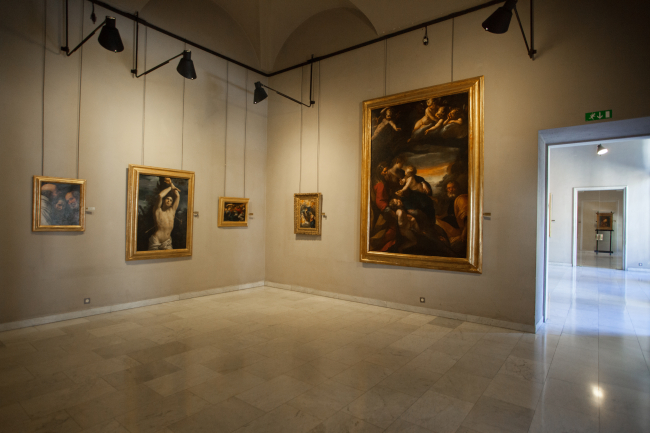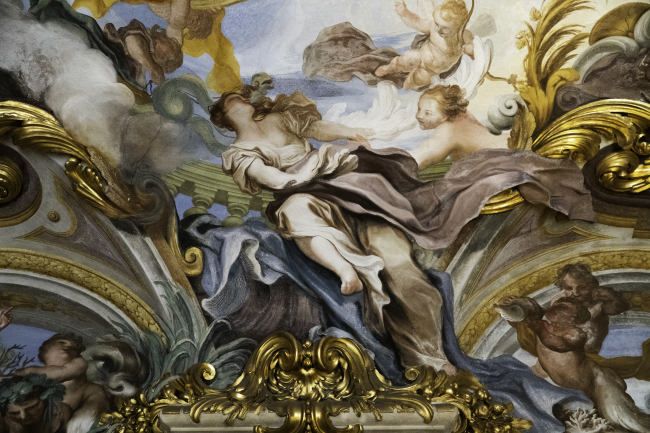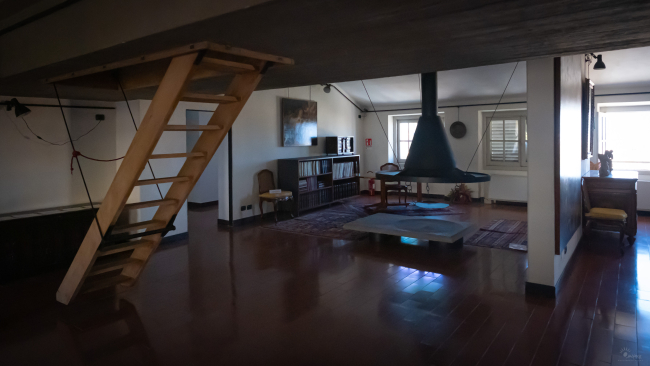Palazzo Rosso
Built for Francesco and Ridolfo Brignole Sale starting from 1671, therefore about a century after the other palaces of Strada Nuova, the palace has the characteristic of having two main floors, to guarantee a prestigious residence for the two brothers; then only the second main floor was decorated with some of the most important fresco cycles of Baroque Genoa, thanks to artists such as Domenico and Paolo Gerolamo Piola, Gregorio De Ferrari, Giovanni Andrea Carlone, Antonio Tavella.
The spectacular residence remained with the Brignole Sale family until 1874, when Maria Brignole Sale De Ferrari, Duchess of Galliera, the last heir of the family, donated it to the Municipality of Genoa to "increase the decorum and usefulness" of Genoa, and to celebrate his family's history forever.
The palace contains the extraordinary art collection of the Brignole Sale, with masterpieces such as seven paintings by Van Dyck, including three family portraits, Veronese's Judith, Guido Reni's Saint Sebastian, Guercino's Cleopatra, the Cook by Bernardo Strozzi and many others.
Palazzo Rosso, as it is traditionally called, is a journey through the living civilization of the Genoese nobility: over the centuries, new spaces are decorated and furnished, creating a true lifestyle encyclopedia, which goes from the early eighteenth century of the very refined “Appartamento delle Mezzarie” of Anton Giulio II to the fifties of the twentieth century, when Franco Albini renovated a private apartment for the director of the Museum Caterina Marcenaro which became a point of reference for Italian design.
Franco Albini and Caterina Marcenaro are also responsible for the restoration of Palazzo Rosso and Palazzo Bianco, after the significant damage of the Second World War: a manifesto of the renewal of Italian museums in the mid-twentieth century.
To find out more about the Palace's collections and for all information for the visit, here is the link to the Museums of Genoa website: https://www.museidigenova.it/it/musei-di-strada-nuova
To learn more about the history of the Palace, here is the link to the information sheet on the Rolli e Strade Nuove website: https://www.rolliestradenuove.it/rollo/19-palazzo-di-francesco-e-ridolfo-brignole-sale/
Built for Francesco and Ridolfo Brignole Sale starting from 1671, therefore about a century after the other palaces of Strada Nuova, the palace has the characteristic of having two main floors, to guarantee a prestigious residence for the two brothers; then only the second main floor was decorated with some of the most important fresco cycles of Baroque Genoa, thanks to artists such as Domenico and Paolo Gerolamo Piola, Gregorio De Ferrari, Giovanni Andrea Carlone, Antonio Tavella.
The spectacular residence remained with the Brignole Sale family until 1874, when Maria Brignole Sale De Ferrari, Duchess of Galliera, the last heir of the family, donated it to the Municipality of Genoa to "increase the decorum and usefulness" of Genoa, and to celebrate his family's history forever.
The palace contains the extraordinary art collection of the Brignole Sale, with masterpieces such as seven paintings by Van Dyck, including three family portraits, Veronese's Judith, Guido Reni's Saint Sebastian, Guercino's Cleopatra, the Cook by Bernardo Strozzi and many others.
Palazzo Rosso, as it is traditionally called, is a journey through the living civilization of the Genoese nobility: over the centuries, new spaces are decorated and furnished, creating a true lifestyle encyclopedia, which goes from the early eighteenth century of the very refined “Appartamento delle Mezzarie” of Anton Giulio II to the fifties of the twentieth century, when Franco Albini renovated a private apartment for the director of the Museum Caterina Marcenaro which became a point of reference for Italian design.
Franco Albini and Caterina Marcenaro are also responsible for the restoration of Palazzo Rosso and Palazzo Bianco, after the significant damage of the Second World War: a manifesto of the renewal of Italian museums in the mid-twentieth century.
To find out more about the Palace's collections and for all information for the visit, here is the link to the Museums of Genoa website: https://www.museidigenova.it/it/musei-di-strada-nuova
To learn more about the history of the Palace, here is the link to the information sheet on the Rolli e Strade Nuove website: https://www.rolliestradenuove.it/rollo/19-palazzo-di-francesco-e-ridolfo-brignole-sale/
Built for Francesco and Ridolfo Brignole Sale starting from 1671, therefore about a century after the other palaces of Strada Nuova, the palace has the characteristic of having two main floors, to guarantee a prestigious residence for the two brothers; then only the second main floor was decorated with some of the most important fresco cycles of Baroque Genoa, thanks to artists such as Domenico and Paolo Gerolamo Piola, Gregorio De Ferrari, Giovanni Andrea Carlone, Antonio Tavella.
The spectacular residence remained with the Brignole Sale family until 1874, when Maria Brignole Sale De Ferrari, Duchess of Galliera, the last heir of the family, donated it to the Municipality of Genoa to "increase the decorum and usefulness" of Genoa, and to celebrate his family's history forever.
The palace contains the extraordinary art collection of the Brignole Sale, with masterpieces such as seven paintings by Van Dyck, including three family portraits, Veronese's Judith, Guido Reni's Saint Sebastian, Guercino's Cleopatra, the Cook by Bernardo Strozzi and many others.
Palazzo Rosso, as it is traditionally called, is a journey through the living civilization of the Genoese nobility: over the centuries, new spaces are decorated and furnished, creating a true lifestyle encyclopedia, which goes from the early eighteenth century of the very refined “Appartamento delle Mezzarie” of Anton Giulio II to the fifties of the twentieth century, when Franco Albini renovated a private apartment for the director of the Museum Caterina Marcenaro which became a point of reference for Italian design.
Franco Albini and Caterina Marcenaro are also responsible for the restoration of Palazzo Rosso and Palazzo Bianco, after the significant damage of the Second World War: a manifesto of the renewal of Italian museums in the mid-twentieth century.
To find out more about the Palace's collections and for all information for the visit, here is the link to the Museums of Genoa website: https://www.museidigenova.it/it/musei-di-strada-nuova
To learn more about the history of the Palace, here is the link to the information sheet on the Rolli e Strade Nuove website: https://www.rolliestradenuove.it/rollo/19-palazzo-di-francesco-e-ridolfo-brignole-sale/
Useful info






